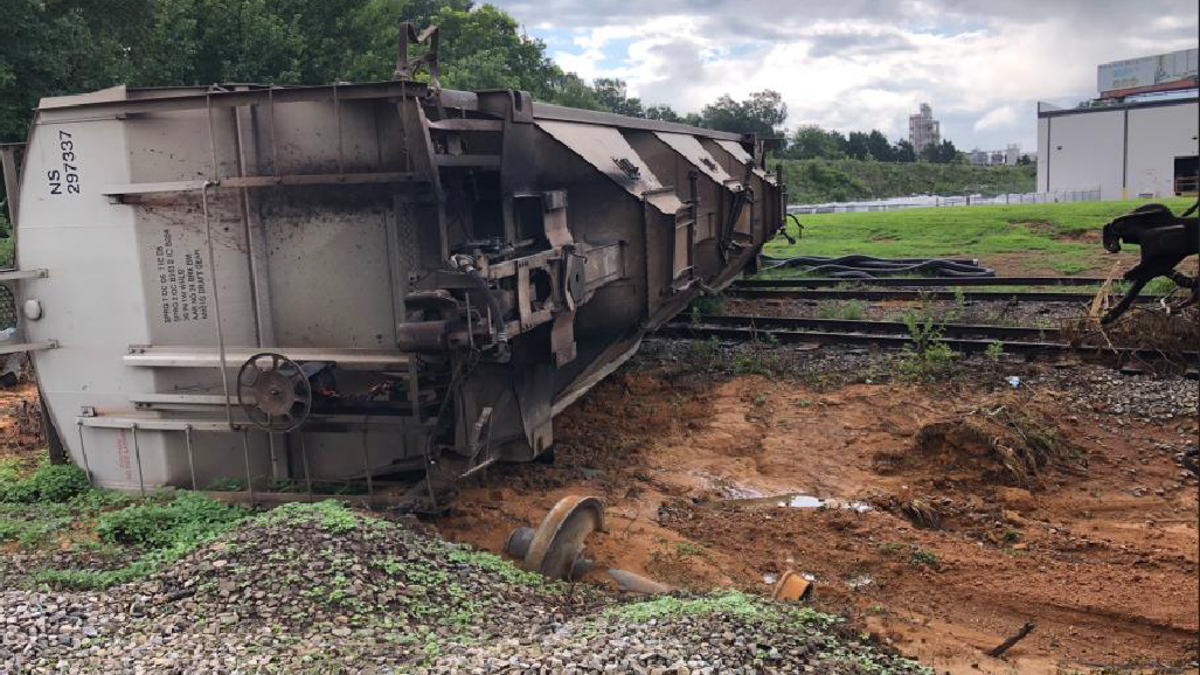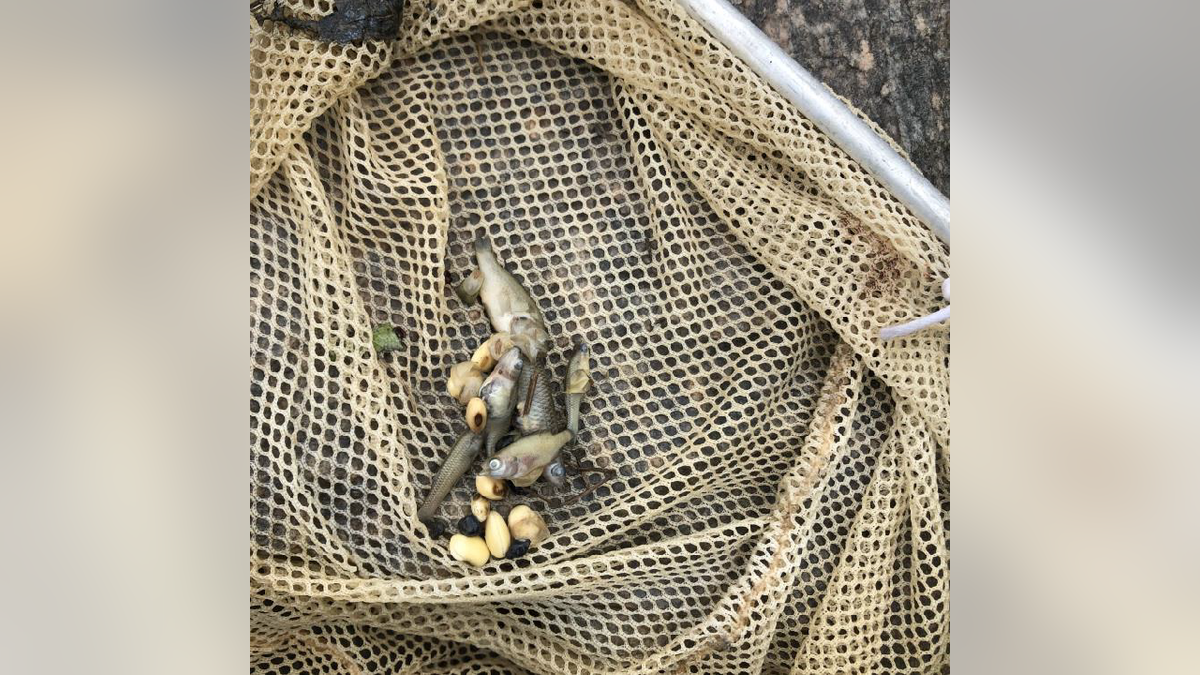Fox News Flash top headlines for August 22
Fox News Flash top headlines are here. Check out what's clicking on Foxnews.com.
A creek in Georgia has had mass fish deaths following a soybean spill that happened roughly one mile away from the area in July.
So far, more than 100 fish have died in Flat Creek, a tributary to Lake Lanier in Hall County, a spokesperson for the Georgia Environmental Protection Division confirmed for Fox News Digital on Monday, Aug. 22.
Last week, local news affiliate FOX 5 Atlanta first reported the deaths, which have been linked to the presence of soybeans in the water system.
"We started noticing the problem with soybeans appearing in the creek, along with discolored water," said Becca Risser, a headwaters watershed specialist at Chattahoochee Riverkeeper – a water quality monitoring nonprofit, in an interview with FOX 5 Atlanta.
MARYLAND MAN WINS $4.4M FOR REELING IN 77.5-POUND WHITE MARLIN
Risser explained that the bacteria that’s breaking down the water-logged soybeans are "[using] up all of the dissolved oxygen in the stream and draw the dissolved oxygen levels down too low for fish to survive."

Researchers working with the Georgia Environmental Protection Division found and sorted dead fish that were discovered around a sewer pipe near Queen City Parkway (Highway 60) in Gainesville, Georgia. This photo was taken on Aug. 12, 2022. (Georgia Environmental Protection Division)
In a statement provided to Fox News Digital, Risser elaborated, "As bacteria feed on the soybeans, they also use oxygen dissolved in the water to fuel their metabolism, just like animals do. This causes the concentration of oxygen in the water to drop too low for fish to survive."
Risser went on, "The state standard for dissolved oxygen in a water body like Flat Creek is 5 mg of oxygen per liter of water, but we have found dissolved oxygen levels below 1 mg/L near the site of the spill."
Experts in the area are attempting to bubble reoxygenate Flat Creek to help fish pull through the soybean presence, Rissier told FOX 5 Atlanta.
Flat Creek is a stream that measures approximately five miles long, according to the National Hydrography Dataset published by the United States Geological Survey.
BOY, 8 YEARS OLD, DISCOVERS GIANT SHARK TOOTH IN SOUTH CAROLINA: 'FIND OF A LIFETIME'
The Georgia Environmental Protection Division’s "Flat Creel Fish Kill Report" from Aug. 12 has counted 21 dead bluegill fish, 74 dead mosquitofish and an unspecified number of dead worms.
An investigation into how the soybeans ended up in Flat Creek is currently underway, according to Risser’s interview with FOX 5 Atlanta.
"We are aware of a train derailment that occurred upstream of here that included three rail cars full of soybeans which tipped over near the headwaters of Flat Creek," she told FOX 5 Atlanta.
Norfolk Southern Railway is the company that transported the soybeans and experienced a derailment last month, according to an statement emailed to FOX 5 Atlanta.
WHAT KILLED TONS OF FISH IN EUROPEAN RIVER? MYSTERY DEEPENS
"On July 29th, three cars from a Norfolk Southern train derailed in Gainesville resulting in a release of soybeans," the Atlanta-based railway company wrote.
"[Norfolk Southern] and our contractors responded immediately and worked to contain and remove the spilled material. There was no impact to Flat Creek," the statement continued. "On Friday, August 12th, we were made aware of soybean material in Flat Creek about a mile away from the site of the derailment."

Three train cars carrying soybeans that belonged to Norfolk Southern Railway derailed on July 29, 2022. The Georgia Environmental Protection Division's Flat Creek Fish Kill Report says fill dirt was used to help equipment access the scene. Damming of nearby water reportedly impeded flow upstream and downstream of the accident. (Georgia Environmental Protection Division)
Fox News Digital reached out to Norfolk Southern to inquire about the possibility of spilled soybeans traveling from the derailment site to Flat Creek through wind or disturbance by wildlife.
CLICK HERE TO GET THE FOX NEWS APP
Norfolk Southern has not been named the cause of the mysterious soybean spill in Flat Creek.
Soybeans have been grown in the Peach State since the 18th century, and it has been a go-to livestock feed, according to agriculture resources published by the University of Georgia Extension school.
"The 180,000 acres that are planted in Georgia each year are mainly used to produce cooking oil, although [College of Agricultural & Environmental Sciences] researchers are busy exploring soybeans' value as an alternative fuel source," the university’s up-to-date soybean guide says.
Norfolk Southern’s statement to FOX 5 Atlanta reiterated that the company promptly responded to the train car derailment.
FOLLOW US ON FACEBOOK FOR MORE FOX LIFESTYLE NEWS
"We have a dedicated staff of environmental experts and contractors with experience in these types of incidents, and immediately responded to assist," Norfolk Southern wrote to FOX 5 Atlanta. "That effort has been ongoing since Friday, and we’ll continue to work with our state partners to identify the source of the material and remove it from the creek."

The Georgia Environmental Protection Division found dead bluegill fish and mosquitofish above the Georgia Avenue section of Flat Creek on Aug. 12, 2022. The creek is located in Gainesville, Georgia. (Georgia Environmental Protection Division)
The railway company added, "It’s important to note that soybeans are not hazardous, though do decompose over time as any other organic material would."
A spokesperson for the Georgia Environmental Protection Division told Fox News Digital that the dead fish were found "about one-mile downstream from the soybean spill," and approximately 100 fish were killed by the beans.
CLICK HERE TO SIGN UP FOR OUR LIFESTYLE NEWSLETTER
"That number may have been higher, but due to the turbid water conditions, our response team could not see the bottom of the stream," the Georgia Environmental Protection Division wrote. "The natural decaying process of organic matter, like soybeans, utilizes oxygen. As the soybeans in the creek decayed, it utilized all available oxygen that was dissolved in the water and subsequently left an insufficient amount of dissolved oxygen for fish and other aquatic organisms."





















